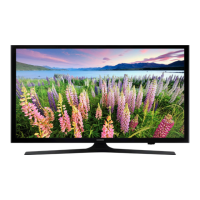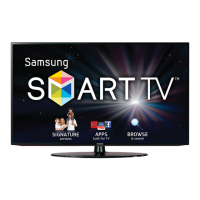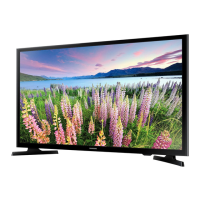Do you have a question about the Samsung UN40J5300AG and is the answer not in the manual?
Connects devices using HDMI cables for optimal picture quality.
Connects devices using component cables for good picture quality.
Connects devices using AV cables for video and audio input.
Connects AV receiver via digital audio optical cable for digital audio output.
Connects TV's audio output to an external device.
Uses HDMI cable to display computer screen on TV.
Uses DVI-to-HDMI cable for computer connection when HDMI is not supported.
Accesses computer files via home network for playback on TV.
Displays mobile device screen on TV using an MHL-to-HDMI cable.
Wirelessly mirrors mobile device screen to TV using Screen Mirroring function.
Connects mobile devices to TV directly without a router using Wi-Fi Direct.
Connects a USB keyboard to the TV's USB port.
Explains how to use various keyboard keys for TV control.
Configures keyboard language, type, and input switching.
Connects a USB mouse to the TV's USB port.
Explains how to use the mouse pointer for TV navigation and control.
Uses Cat 7 LAN cables to connect the TV to internet access points.
Automatically connects to an available wireless network using SSID and security key.
Manually configures wireless network settings like IP address for connection.
Connects to a wireless network using WPS push button configuration.
Addresses issues like no network cable found, IP auto setting failure, etc.
Addresses issues like wireless network connection failed, IP auto setting failure, etc.
Diagnoses issues with Smart Hub functionality and internet connection.
Adds frequently used items to a personalized favorite list.
Clears the TV's browsing history.
Guides through the process of creating a new Samsung account.
Details the process of logging in and saving account information.
Explains how to quickly log in using a previously saved account.
Links specific app accounts (e.g., Facebook) to the Samsung account.
Unlinks a previously connected service account.
Installs apps directly from the popular or category lists.
Installs apps after reviewing their detailed information.
Opens the e-manual via menu or dedicated button.
Searches the e-manual using keywords.
Explains different ways to navigate the web browser.
Overview of the web browser's command and status bar elements.
Limits access to specific pre-registered web pages.
Enables/disables private browsing mode, which doesn't save history.
Configures Picture-in-Picture settings for web browsing.
Sets the default search engine for the browser.
Deletes a single application from the TV.
Enables/disables push notifications from apps.
Allows using app features while watching TV broadcasts.
Plays photos, videos, and music from connected USB storage devices.
Explains the correct procedure for removing USB devices.
Grants permission for devices to connect and play media on the TV.
Accesses and plays media files shared via a home network.
Accesses options for slideshow speed, effects, rotation, zoom, etc.
Accesses video playback settings like scene selection, subtitles, and repeat modes.
Accesses music playback settings like repeat, shuffle, speakers, and sound mode.
Filters media content by type (photo, video, music).
Accesses options for slide show, play selected, send, encoding, etc.
Accesses guide functions for channel lists and program schedules.
Displays detailed information about selected programs.
Sets up schedule viewing for digital and analog channels.
Cancels scheduled viewing sessions.
Modifies settings for existing scheduled viewing sessions.
Designates frequently watched channels as favorites.
Removes channels from the index or adds back removed channels.
Blocks programs based on rating to control content for children.
Locks or unlocks selected channels using a password.
Adds the current or multiple channels to a favorites list.
Lists options available on the Edit Favorites screen.
Enables watching TV broadcasts with captions.
Chooses the subtitle mode for broadcasts.
Activates or deactivates the Picture-in-Picture function.
Adjusts the size of the PIP sub-picture.
Sets the position of the PIP sub-picture.
Selects the audio source for PIP.
Selects the preferred audio language for digital channels.
Selects the digital audio output format.
Adjusts audio settings for multi-track sound broadcasts.
Explains different picture modes like Dynamic, Standard, Natural, Movie, Entertain, Stadium.
Applies current picture settings to all or current input sources.
Automatically adjusts screen contrast for optimal setting.
Adjusts the depth of black colors.
Adjusts skin tones by darkening or lightening.
Individually adjusts red, green, and blue levels.
Adjusts the range of colors displayed by the TV.
Adjusts the overall color tone of the picture.
Reduces static and ghosting for cleaner images.
Adjusts black level for HDMI connections to compensate for low contrast.
Optimizes picture quality specifically for watching movies.
Explains various screen size options like 16:9, Zoom, Wide Fit, 4:3, Screen Fit, Custom.
Explains various sound modes like Standard, Music, Movie, Clear Voice, Amplify, Stadium.
Provides surround sound experience like in a theater.
Enhances dialogue clarity.
Chooses the audio output speakers (TV, receiver, or both).
Optimizes sound based on whether the TV is wall-mounted or on a stand.
Corrects timing mismatches between audio and video.
Automatically adjusts volume fluctuations between channels.
Sets the TV's internal clock manually or automatically.
Manually enters the current time and date.
Sets the TV to automatically shut off after a specified period.
Schedules the TV to turn on automatically at a specific time.
Activates screen protection to prevent after-images.
Reduces power consumption through Eco Solution features.
Enables/disables Anynet+ features and searches for compatible devices.
Selects an external HDMI-CEC device for control.
Accesses the menu and tools of the connected external device.
Downloads and installs software updates online.
Installs software updates using a USB flash drive.
Scans the TV and connected media for malicious code.
Adjusts the opacity of the TV's menu display.
Applies high contrast mode for better text readability.
Zooms in on focused items within the Smart Hub interface.
Views system event messages and service notifications.
Allows remote diagnosis and assistance from Samsung technicians.
Uses a picture test to diagnose if the TV or an external device is the cause of issues.
Addresses issues with flickering or dimming picture.
Troubleshoots color issues related to component connections.
Adjusts picture settings for brightness.
Resolves issues where the TV turns off unexpectedly.
Troubleshoots problems with turning the TV on.
Resolves issues with not receiving all channels.
Addresses issues like image not looking as good as in store or being distorted.
Troubleshoots poor color, missing color, or insufficient brightness.
Adjusts picture size for borders and troubleshoots black and white display.
Uses a sound test to diagnose audio problems.
Resolves issues with channel reception, missing captions, and picture distortion.
Addresses 'Mode Not Supported' and lack of audio during computer connection.
Resolves wireless connection failures and software update issues.
Addresses general Anynet+ problems, starting, exiting, and device display issues.
Resolves app language differences and application not working issues.
Explains that high-bitrate files may cause playback problems.
Resets TV settings and Smart Hub accounts to defaults.
Covers TV heat, picture display, mode not supported, grayed-out captions, plastic smell, and signal info.
Details supported file types, USB requirements, file limits, and file sending methods.
Details supported picture sizes for various input signals.
Instructions for installing an anti-theft lock for security.
Outlines precautions, supported protocols, and WPS for wireless internet.
Explains resolution standards (480i/p, etc.) and interface types (DVI, HDMI).











